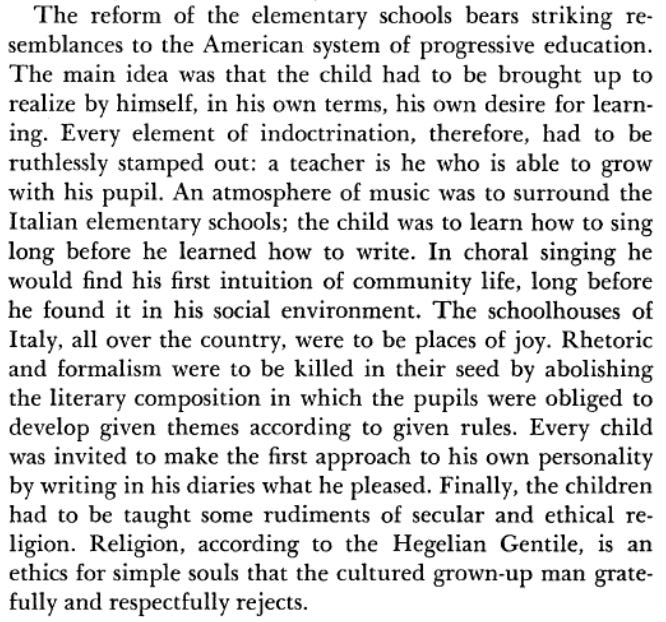Education, Fascism, and the Downward Spiral
The silent march of American education follows closely in the footsteps of Mussolini's Italy.
Education in the United States has been deteriorating for the better part of a century. Coinciding with the rise of the military-industrial complex following the First World War, this decline has quietly guided the nation along the downward path from liberalism to its natural fascist destination. This flawed ideology, when intertwined with a particular brand of education, further fuels the military-industrial complex and leads, inevitably to war.
The appeal of fascism to an agitated and dispirited middle class has been one of the ideology’s most common features throughout history. When hit with an economic or societal shock such as the recent COVID-19 pandemic or the attacks of 9/11, the middle class must rely on a firm cultural identity to defend against the temptation of authoritarianism in the face of confusion and fear. Without the philosophical discernment that comes from a cultivated culture, the fearful people, in order to preserve a sense of common identity, turn to nationalism.
To live in a nation implies the existence of other nations as well. Lacking qualitative features beyond a physical location, nationalism elicits an antonymous view of foreign cultures and peoples in the collective conscious. To state it plainly, it is this process that leads to what most of us would now call xenophobia. Fascism cannot exist without some form of disdainful ideology of superiority - sometimes in the form of racism or, for example, the censorship of a particular language.
It is for this reason that fascisms decline begins at its start. The mind of a fascist must continually struggle against a conjectural enemy that is - at the same time - inherently inferior and threatening enough to warrant government action. The manifestation of such a contradiction in belief was perhaps best articulated by Umberto Eco. A writer and philosopher born into Mussolini’s Italy of the last century, Eco wrote that “Fascist governments are condemned to lose wars because they are constitutionally incapable of objectively evaluating the force of the enemy.”
The ignorance of xenophobia cannot, however, thrive in an educated and critical mind. Thus, control of a nation’s education system is vital for a fascist regime to gain power. Upon examination, the historical example of Fascist Italy, evolutions in education are immediately recognizable to a modern American. Allow me, if you will, to briefly explain the story of education reform in early 20th century Italy:*
WHAT DOES FASCIST EDUCATION LOOK LIKE?
State-supervised elementary schools began to be implemented throughout Italy in latter half of the 19th century. As the education system established itself in Italian society, secondary and higher education institutions followed suit, pushing the literacy rate to 73% by 1921.* Ten years after that the literacy rate in Italy (nine years into the Fascist regime) was the same as that of the modern United States - 79%.* It was then that the Italian middle class began to flock to universities in larger and larger numbers. Turning out large numbers of teachers and attorneys, the largest employer of successful graduates was the Italian state. Sound familiar yet?
Giovanni Gentile was a self-proclaimed liberal up until the Fascists came to power in 1922, but experienced little difficulty changing his label to fascist. After all, the only real difference he could observe was that the Fascists were more “rough” in their ascent to power, and surely such a minor detail could be easily overlooked. It was Gentile who served in the First Fascist cabinet of Italy as Minister of Public Education. Max Ascoli described the education system drafted by Gentile in a research paper of which I have provided an excerpt below.
In the matter of a year this system was codified into law and considered by Mussolini to be one of his “most Fascist” accomplishment. Educational institutions were decidedly scientific in their focus - the Italian system found no value in the subject of history itself as well as the historical anthologies of the other subjects. The common belief was that history did not actually explain anything but rather just stated inconsequential facts.
In 1929, control of the education system was entirely given over to the Jesuits as a result of the Lateran Treaties. The nature of the material changed slightly, being infused with religious sentiments and stripped of much of the scientific methodology, but the system itself - it’s structure and format - remained as it had been. The result of this was an education system that could be relied upon to teach the average student basic reading skills - enough to get by - and elementary arithmetic - enough to handle basic commercial transactions. Whatever else a student learned was a result of circumstances outside the control of the system in-and-of itself.
Recall the cultural deficit mentioned previously in this article and you will see how fascist ‘logic’ functions as a positive feedback loop, spiraling deeper and deeper into collective pathology. What we see in Mussolini’s system of education is an environment rich for fascist governments. The indiscriminate masses, already war-like in their nationalism, listen to the rhetoric of their leaders with little skepticism. A fascist public does not poke or pry into the military-industrial complex profiting a powerful and unviolable elite.
The militaristic hierarchy converges with the intellectual void, creating a culture in which every man has his own set of inferiors to despise. As he busies himself exploiting his inferiors, it does not occur to him that his superiors are likewise exploiting him. This is replicated, unremarked, up and down the hierarchy. In this way, every man is ready to distinguish himself as a hero without ever knowing what a hero is.
-The Shultz Report by M. Shultz




